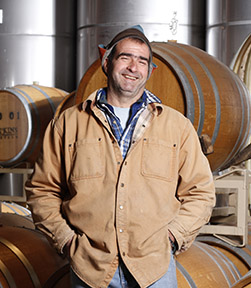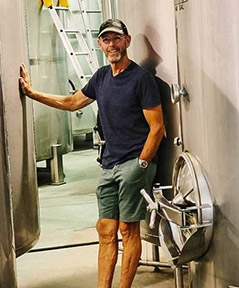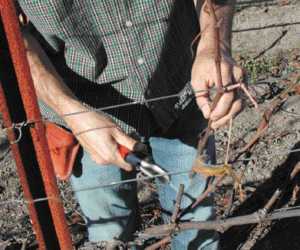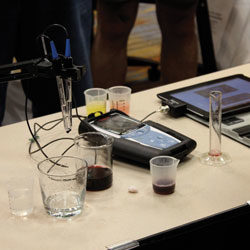French-American hybrid varieties allow wine grapes to be grown in locations that European varieties cannot succeed. However, hybrids often require extra attention in the winery as they are notorious for higher acidity, lower tannins, and color instability. There are many ways to address these potential shortfalls, and the choices a winemaker makes can really show their talent. We asked three pros who grow hybrids to share their advice for crafting award-winning wines from them.
Giacomo “Jim” Verde is the Owner and Winemaker at Verde Vineyards in Johnston, Rhode Island

The hybrids we grow in our Rhode Island vineyard off Moswansicut Lake include the red varieties St. Croix and Petite Pearl, as well as the white grapes La Crescent, Itasca, and Cayuga White. Each has its own personality and although they are more resistant to diseases than the vinifera varieties, they still need to be sprayed with fungicides. La Crescent is particularly susceptible to downy mildew and Cayuga to sour rots. We also grow the vinifera varieties Merlot, Cabernet Franc, and Lemberger (also called Blaufränkisch). Of these three, Merlot presents the greatest challenge to grow in our region as it is susceptible to cold damage. The vineyard is about 20 miles from the Atlantic Coast where the winters are milder than much of New England, so we do have success with these varieties. The vinifera varieties need to be sprayed more often than the hybrids. New England weather is quite variable and poses challenges from year-to-year. This past July 2021 was quite rainy and humid and promoted the growth of fungal diseases, especially black rot. And we are always worried about cold spells, which are deadly for the vinifera. The hybrids have withstood many below-zero nights unscathed. While we are primarily talking about creating balance in the winery, it is important to understand the impact that weather and viticulture decisions play in the resulting grapes.
Our St. Croix is picked at 18 °Brix. As the grapes ripen more than that the berries tend to fall off and of course there is always the danger of getting a “foxiness” to the wine. Foxiness means the wine will have the aromas of a wild grape (Vitis labrusca, called the fox grape) — a mutant of which is the Concord grape, which will give the wine aromas like Welch’s grape juice. The St. Croix hybrid is a genetic mixture of wild grape genes and varieties from Europe. The wild genes give the hybrid variety resistance to cold and indigenous diseases and the European varieties contribute pleasant flavors and aromas. For our other hybrids; Cayuga is picked at 19 °Brix while Petite Pearl, La Crescent, and Itasca are harvested at 24 °Brix. We make dry wines so sugar levels are controlled.
Since the hybrids are on the acidic side, choosing a yeast strain that reduces acidity is important. The addition of sugar also helps fight high acidity. Sometimes we also adjust acidity with a bit of potassium bicarbonate. Tartaric acid is reduced considerably by cold stabilization and by blending the red hybrids with red vinifera varieties. Most of our hybrids are used, however, to make varietal wines. We do not cold stabilize the reds.
The one hybrid/vinifera blend we make is called Surveyor, and is a blend of Cabernet Franc, Lemberger, Merlot, and St. Croix. It is a well-balanced red wine that is a combination of a true blend and field blend.
Tannin additions are uncommon for us as the hybrid grapes we grow actually come through with good balance. Enzymes are only used for the whites.
James Baker is the Winemaker and Vineyard Manager at Hopkins Vineyard in Warren, Connecticut

We work with a lot of hybrid grapes including Cayuga White, Seyval Blanc, Vidal Blanc, Corot Noir, and Traminette, as well as a number of vinifera grapes including Chardonnay, Riesling, Cabernet Franc, Saperavi, Dornfelder, Zweigelt, and Lemberger. Corot Noir is the only red hybrid we grow — in a good year I am looking for 19–21 °Brix, 3.4 pH, and a titratable acidity (TA) of 8.0–9.0. Even in those ideal years I’ll usually add some sugar to result in an appropriate alcohol after fermentation (I typically try to make our Corot Noir at 11–12% ABV). Of course, not every vintage is ideal. I have harvested the Corot Noir at 16.5 °Brix, 3.1 pH, and a TA of 9.5. When we get grapes like that I’ll add sugar and do a full malolactic fermentation, as well as use different yeast strains to reduce the acid (usually Lalvin 71B-1122, but I have also used CSM from Scott Labs and Lalvin ICV-GRE). I prefer that the grapes and growing season dictate the wine. Still, I am consistent with the wine style that Corot Noir makes annually — which is a dry red wine aged in barrels. I don’t normally blend it with a vinifera as we like the varietal character. This past year was wet and I found the grapes were a little behind normal, leading to a slightly later harvest, more sugar added, and more malolactic culture.
To help with the color in the Corot Noir I punch down the cap during fermentation at a high temperature of 85–90 °F (29–32 °C). I also use tannins and enzymes to stabilize the color. I use fermentation tannins from Scott Labs and, if needed, an aging or finishing tannin.
For home winemakers, the best advice is to get the best fruit possible. But even if it isn’t perfect, there are many options available to help you make a good wine.
Peter Botham is the Owner and Winemaker at Botham Vineyards in Barneveld, Wisconsin

We grow Marechal Foch and Leon Millot at our estate vineyard, and I also have experience with numerous other French hybrids: Seyval Blanc, Vidal Blanc, DeChaunac, and Geisenheim, to name a few. The only vinifera we buy is Riesling.
We rarely reach full ripeness in our climate so our expectations are a pretty low bar when it comes to the “typical” numbers winemakers in other regions are accustomed to. If we get to 20 °Brix and pH of around 3 or so we are pretty happy. The only adjustments I ever make to our crop is to add sugar to reach an alcohol level that is appropriate for any given wine (which generally range from about 10.5% ABV up to 13% ABV for our red table wines).
In a poor growing year I have had fruit come in with a Brix at 17 and a pH of 2.8 — way green. The only options with fruit like that are to either blend it off into another wine to alleviate the problem or craft a wine from it where those characteristics are an asset. Fruit always determines the wine that it gets crafted into. There is no point in trying to make a wine out of fruit that doesn’t have what it needs to succeed. No matter what you do, French hybrid is not going to ever magically evolve into vinifera. I run into so many wines where the winemaker thinks that oak will somehow turn a hybrid into Cabernet. Foolish. Make wine where the fruit is at its best. In the case of every hybrid I’ve encountered, that means fruit-forward with a light body — wines that are fresh and easy to drink.
When you have less than ripe fruit, which is very common in Wisconsin, you need to work the fermentation
very hard to get everything available. In the case of color, that involves multiple pumpovers/punchdowns on a daily basis and maybe let a little more heat develop than would normally be tolerated.
The best advice I can give any winemaker, home or commercial, is to always start with the best fruit you can get your hands on. If you are a grower as well, concentrate on every best effort to bring in a quality crop. Good fruit is like a Porsche; there is no substitute.






